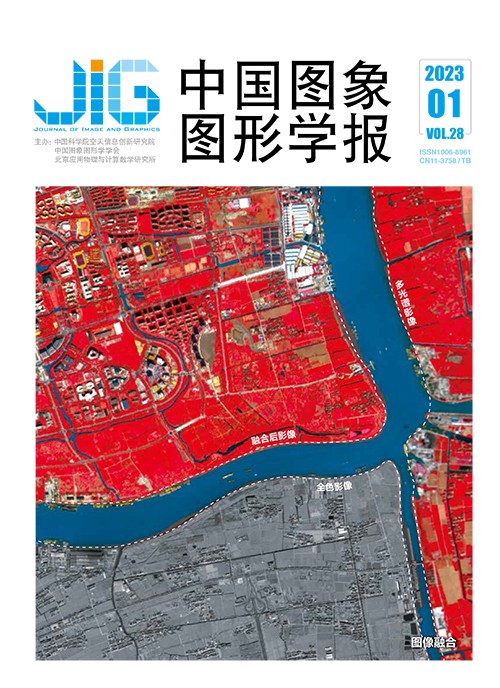
多尺度自适应融合的肝脏肿瘤检测
马金林1,2, 欧阳轲1, 马自萍1, 毛凯绩1, 陈勇3(1.北方民族大学计算机科学与工程学院, 银川 750021;2.北方民族大学图像图形智能处理国家民委重点实验室, 银川 750021;3.宁夏医科大学总医院放射介入科, 银川 750004) 摘 要
目的 针对肝脏肿瘤检测方法对小尺寸肿瘤的检测能力较差和检测网络参数量过大的问题,在改进EfficientDet的基础上,提出用于肝脏肿瘤检测的多尺度自适应融合网络MAEfficientDet-D0(multiscale adaptive fusion network-D0)和MAEfficientDet-D1。方法 首先,利用高效倒置瓶颈块替换EfficientDet骨干网络的移动倒置瓶颈块,在保证计算效率的同时,有效解决移动倒置瓶颈块的挤压激励网络维度和参数量较大的问题;其次,在特征融合网络前添加多尺度块,以扩大网络有效感受野,提高体积偏小病灶的检测能力;最后,提出多通路自适应加权特征融合块,以解决低层病灶特征图的语义偏弱和高层病灶特征图的细节感知能力较差的问题,提高了特征的利用率和增强模型对小尺寸肝脏肿瘤的检测能力。结果 实验表明,高效倒置瓶颈层在少量增加网络复杂性的同时,可以有效提高网络对模糊图像的检测精度;多通路自适应加权特征融合模块可以有效融合含有上下文信息的深层特征和含有细节信息的浅层特征,进一步提高了模型对病灶特征的表达能力;多尺度自适应融合网络对肝脏肿瘤检测的效果明显优于对比模型。在LiTS(liver tumor segmentation)数据集上,MAEfficientDet-D0和MAEfficientDet-D1的mAP(mean average precision)分别为86.30%和87.39%;在3D-IRCADb(3D image reconstruction for comparison of algorithm database)数据集上,MAEfficientDet-D0和MAEfficientDet-D1的mAP分别为85.62%和86.46%。结论 本文提出的MAEfficientDet系列网络提高了特征的利用率和小病灶的检测能力。相比主流检测网络,本文算法具有较好的检测精度和更少的参数量、计算量和运行时间,对肝脏肿瘤检测模型部署于嵌入式设备和移动终端设备具有重要参考价值。
关键词
Multiscale adaptive fusion network based algorithm for liver tumor detection
Ma Jinlin1,2, Ouyang Ke1, Ma Ziping1, Mao Kaiji1, Chen Yong3(1.School of Computer Science and Engineering, North Minzu University, Yinchuan 750021, China;2.Key Laboratory of Image and Graphics Intelligent Processing of State Ethnic Affairs Commission, North Minzu University, Yinchuan 750021, China;3.Department of Interventional Radiology, General Hospital of Ningxia Medical University, Yinchuan 750004, China) Abstract
Objective Human liver-detected computerized tomography (CT) images are widely used in the diagnosis of liver diseases. CT images-based liver tumors’ symptom is varied in related to its shape, size and location and its low contrast is projected with adjacent tissues. However, the challenging issues are concerned of poor detection ability of small-sized tumors in liver tumor detection and a huge number of parameters of detection network. These challenges are mainly involved in as mentioned below: 1) weak detection ability of small lesions; 2) large amount of model parameters-derived low efficiency and high computational cost; 3) less semantic feature description ability of the model for low-level feature map lesions; 4) poor details-perceptive ability for high-level feature map lesions. In order to solve these problems and improve the detection and recognition ability of the model, we develop a multi-scale EfficientDet-based adaptive fusion network (MAEfficientDet-D0, MAEfficientDet-D1) for liver tumor detection. Method A multiscale adaptive fusion network method, called MAEfficientDet, is facilitated for liver tumor detection. Our contribitions are based the key asepcts as following: 1) first, efficient inverted bottleneck (EFConv) is designed to replace the mobile inverted bottleneck block of EfficientDet backbone network with efficient inverted bottleneck block, which can effectively reolve the problem of large dimensions and parameters of the squeeze excitation network of mobile-inverted bottleneck block. The structure of the EFConv is to construct multi-channel of input image by expanding convolution to obtain more feature layers. Next, the depth separable convolution is used to extract the features of each layer. Third, a local channel-across interaction strategy with no dimension-reduced is used to realize channel-cross information interaction, and one-dimensional convolution is used to reduce the complexity of the model significantly. Fourth, the number of channels is compressed by dimensional-reduced convolution. Finally, the residual connection is used to alleviate the gradient dispersion and improve the parameter-transfering ability for network model training efficiency. 2) The multiscale blocks (Multiscale-A,Multiscale-B) are focused regional features of liver lesions to expand the effective receptive field of the network and improve the detection ability of small lesions. The internal structure of multi-scale blocks can be divided into multi-branch convolution layers of different cores and maximum pooling operations. Its characteristics are illustrated below: (1) adopting 1 × 1 convolution filtering useless information; (2) using different convolution kernels for different branches to obtain characteristic graphs of different sizes; (3) using the maximum pool operation of different receptive fields to reduce the size of the characteristic map and prevent the network from over fitting; (4) using residuals to improve the efficiency of network parameter transmission. 3) Using multi-channel adaptive weighted feature fusion block (MAWFF) to adaptively fuse the high-level semantic features and the low-level fine-grained features of the liver tumor image. The problems of weak semantics of the low-level lesion feature map and poor details perception of the high-level lesion feature map can be resolved further and the utilization of features and the detection ability of the model are improved. The experimental datasets are composed of liver tumor segmentation challenge dataset (LiTS) and 3D image reconstruction for comparison of algorithm database (3D-IRCADb). Result The experiments show that the efficient inversion of bottleneck layer can improve the detection accuracy of fuzzy images effectively while improving a small amount of network complexity. The multi-channel adaptive feature-weighted fusion module fuses the deep features-contextual information effectively and the features-shallowed detail information, which improves the demonstration ability of the model to the lesion features further. The effect of multi-scale adaptive fusion network on liver tumor detection is significantly developed and optimized in terms of the comparative analyses as listed below: 1) LiTS-based: MAEfficientDet-D0 is higher than EfficientDet-D0 by 7.48%, 9.57%, 6.42%, 7.96% and 8.52%, respectively. MAEfficientDet-D1 is increased by 3.47%, 6.64%, 6.33%, 8.12% and 5.02% of each beyond EfficientDet-D1. 2) 3D-IRCADb-based: MAEfficientDet-D0 is increased by 5.51%, 9.82%, 6.16%, 7.39% and 7.63%, respectively beyond EfficientDet-D0. MAEfficientDet-D1 is increased by 5.87%, 6.24%, 5.81%, 9.39% and 6.05%, respectively beyond EfficientDet-D1. Conclusion Our MAEfficientDet-D0 and MAEfficientDet-D1 architectures improve the utilization of features and the detection ability of small lesions. Our detection algorithm has better results on detection accuracy, less parameter amount, calculation cost and running time, as well as its potentials for embedded devices and mobile terminal devices.
Keywords
MAEfficientDet efficient inverted bottleneck block multiscale block multichannel feature fusion adaptive weighting
|



 中国图象图形学报 │ 京ICP备05080539号-4 │ 本系统由
中国图象图形学报 │ 京ICP备05080539号-4 │ 本系统由